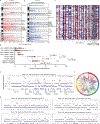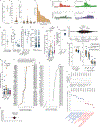Genomic signature of Fanconi anaemia DNA repair pathway deficiency in cancer
- PMID: 36450981
- PMCID: PMC10202100
- DOI: 10.1038/s41586-022-05253-4
Genomic signature of Fanconi anaemia DNA repair pathway deficiency in cancer
Abstract
Fanconi anaemia (FA), a model syndrome of genome instability, is caused by a deficiency in DNA interstrand crosslink repair resulting in chromosome breakage1-3. The FA repair pathway protects against endogenous and exogenous carcinogenic aldehydes4-7. Individuals with FA are hundreds to thousands fold more likely to develop head and neck (HNSCC), oesophageal and anogenital squamous cell carcinomas8 (SCCs). Molecular studies of SCCs from individuals with FA (FA SCCs) are limited, and it is unclear how FA SCCs relate to sporadic HNSCCs primarily driven by tobacco and alcohol exposure or infection with human papillomavirus9 (HPV). Here, by sequencing genomes and exomes of FA SCCs, we demonstrate that the primary genomic signature of FA repair deficiency is the presence of high numbers of structural variants. Structural variants are enriched for small deletions, unbalanced translocations and fold-back inversions, and are often connected, thereby forming complex rearrangements. They arise in the context of TP53 loss, but not in the context of HPV infection, and lead to somatic copy-number alterations of HNSCC driver genes. We further show that FA pathway deficiency may lead to epithelial-to-mesenchymal transition and enhanced keratinocyte-intrinsic inflammatory signalling, which would contribute to the aggressive nature of FA SCCs. We propose that the genomic instability in sporadic HPV-negative HNSCC may arise as a result of the FA repair pathway being overwhelmed by DNA interstrand crosslink damage caused by alcohol and tobacco-derived aldehydes, making FA SCC a powerful model to study tumorigenesis resulting from DNA-crosslinking damage.
© 2022. The Author(s), under exclusive licence to Springer Nature Limited.
Conflict of interest statement
Figures














References
-
- Sasaki MS & Tonomura A A high susceptibility of Fanconi’s anemia to chromosome breakage by DNA cross-linking agents. Cancer Res 33, 1829–1836 (1973). - PubMed
Methods References
-
- Auerbach AD & Schroeder TM First announcement of the Fanconi anemia International Registry. Blood 60, 1054 (1982). - PubMed
-
- Wellcome-Sanger. Cancer Genome Project – Cancer IT Pipeline. Github; (https://github.com/cancerit/).
-
- Li H Aligning sequence reads, clone sequences and assembly contigs with BWA-MEM. bioRxiv, doi:arXiv:1303.3997v2 (2013).
Publication types
MeSH terms
Substances
Grants and funding
LinkOut - more resources
Full Text Sources
Medical
Molecular Biology Databases
Research Materials
Miscellaneous

